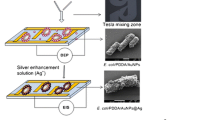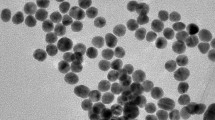Abstract
Sample preparation and processing steps are the most critical assay aspects that require our attention in the development of diagnostic devices for analytes present in complex matrices. In the best scenarios, diagnostic devices should use only simple sample processing. We have therefore investigated minimal preparation of stool samples and their effect on our sensitive microfluidic immunosensor for the detection of cholera toxin. This biosensor was previously developed and tested in buffer solutions only, using either fluorescence or electrochemical detection strategies. The microfluidic devices were made from polydimethylsiloxane using soft lithography and silicon templates. Cholera toxin subunit B (CTB)-specific antibodies immobilized onto superparamagnetic beads and ganglioside GM1-containing liposomes were used for CTB recognition in the detection system. Quantification of CTB was tested by spiking it in human stool samples. Here, optimal minimal sample processing steps, including filtration and centrifugation, were optimized using a microtiter plate assay owing to its high-throughput capabilities. Subsequently, it was transferred to the microfluidic systems, enhancing the diagnostic characteristic of the biosensor. It was found that the debris removal obtained through simple centrifugation resulted in an acceptable removal of matrix effects for the fluorescence format, reaching a limit of detection of only 9.0 ng/mL. However, the electron transfer in the electrochemical format was slightly negatively affected (limit of detection of 31.7 ng/mL). Subsequently, cross-reactivity using the heat-labile Escherichia coli toxin was investigated using the electrochemical microfluidic immunosensors and was determined to be negligible. With minimal sample preparation required, these microfluidic liposome-based systems have demonstrated excellent analytical performance in a complex matrix and will thus be applicable to other sample matrices.







Similar content being viewed by others
References
Terry SC, Jerman JH, Angell JB (1979) A gas chromatographic air analyzer fabricated on a silicon wafer. IEEE Transl Electron Devices 26:1880–1886
Mir M, Homs A, Samitier J (2009) Integrated electrochemical DNA biosensors for lab-on-a-chip devices. Electrophoresis 30:3386–3397
Choi S, Goryll M, Sin LYM, Wong PK, Chae J (2011) Microfluidic-based biosensors toward point-of-care detection of nucleic acids and proteins. Microfluid Nanofluid 10:231–247
Darain F, Yager P, Gan KL, Tjin SC (2009) On-chip detection of myoglobin based on fluorescence. Biosens Bioelectron 24:1744–1750
Heinze BC, Song JY, Lee CH, Najam A, Yoon JY (2009) Microfluidic immunosensor for rapid and sensitive detection of bovine viral diarrhea virus. Sensors Actuators B 138:491–496
Heinze BC, Gamboa JR, Kim K, Song JY, Yoon JY (2010) Microfluidic immunosensor with integrated liquid core waveguides for sensitive Mie scattering detection of avian influenza antigens in a real biological matrix. Anal Bioanal Chem 398:2693–2700
Pereira SV, Bertolino FA, Fernández-Baldo MA, Messina GA, Salinas E, Sanz MI, Raba J (2011) A microfluidic device based on a screen-printed carbon electrode with electrodeposited gold nanoparticles for the detection of IgG anti-Trypanosoma cruzi antibodies. Analyst 136:4745–4751
Zhang H, Fu X, Liu L, Zhu Z, Yang K (2012) Microfluidic bead-based enzymatic primer extension for single-nucleotide discrimination using quantum dots as labels. Anal Biochem 426:30–39
Liu Y, Wang H, Huang J, Yang J, Liu B, Yang P (2009) Microchip-based ELISA strategy for the detection of low-level disease biomarker in serum. Anal Chim Acta 650:77–82
Kellner C, Botero ML, Latta D, Drese K, Fragoso A, O'Sullivan CK (2011) Automated microsystem for electrochemical detection of cancer markers. Electrophoresis 32:926–930
Chikkaveeraiah BV, Mani V, Patel V, Gutkind JS, Rusling JF (2011) Microfluidic electrochemical immunoarray for ultrasensitive detection of two cancer biomarker proteins in serum. Biosens Bioelectron 26:4477–4483
Arévalo FJ, Granero AM, Fernández H, Raba J, Zón MA (2011) Citrinin (CIT) determination in rice samples using a micro fluidic electrochemical immunosensor. Talanta 83:966–973
Chiriacò MS, Primiceri E, D’Amone E, Ionescu RE, Rinaldi R, Maruccio G (2011) EIS microfluidic chips for flow immunoassay and ultrasensitive cholera toxin detection. Lab Chip 11:658–663
Liang W, Li Y, Zhang B, Zhang Z, Chen A, Qi D, Yi W, Hu C (2012) A novel microfluidic immunoassay system based on electrochemical immunosensors: an application for the detection of NT-proBNP in whole blood. Biosens Bioelectron 31:480–485
WHO (2013) Cholera. http://www.who.int/topics/cholera/en/. Accessed 25 Mar 2013
McDowall J (2005) Cholera toxin. http://www.ebi.ac.uk/interpro/potm/2005_9/Page1.htm. Accessed 7 Jan 2008
Bunyakul N, Edwards KA, Promptmas C, Baeumner AJ (2009) Cholera toxin subunit B detection in microfluidic devices. Anal Bioanal Chem 393:177–186
Goral VN, Zaytseva NV, Baeumner AJ (2006) Electrochemical microfluidic biosensor for the detection of nucleic acid sequences. Lab Chip 6:414–421
Zaytseva NV, Goral VN, Montagna RA, Baeumner AJ (2005) Development of a microfluidic biosensor module for pathogen detection. Lab Chip 5:805–811
Kwakye S, Baeumner AJ (2003) A microfluidic biosensor based on nucleic acid sequence recognition. Anal Bioanal Chem 376:1062–1068
Bartlett GR (1959) Phosphorus assay in column chromatography. J Biol Chem 234:466–468
Gottschalk PG, Dunn JR (2005) The five-parameter logistic: a characterization and comparison with the four-parameter logistic. Anal Biochem 343:54–65
Thompson V, Schatzlein D, Mercuro D (2003) Limits of detection in spectroscopy. Spectroscopy 18(12):112–114
Rivero-Marcotegui A, Olivera-Olmedo JE, Valverde-Visus FS, Palacios-Sarrasqueta M, Grijalba-Uche A, García-Merlo S (1998) Water, fat, nitrogen, and sugar content in feces: reference intervals in children. Clin Chem 44(7):1540–1544
Selby C (1999) Interference in immunoassay. Ann Clin Biochem 36:704–721
Zhaoa H, Bian X, Galligan JJ, Swain GM (2010) Electrochemical measurements of serotonin (5-HT) release from the guinea pig mucosa using continuous amperometry with a boron-doped diamond microelectrode. Diam Relat Mater 19:182–185
Holmgren J, Lonnroth I, Mansson J, Svennerholm L (1975) Interaction of cholera toxin and membrane GM1 ganglioside of small intestine. Proc Natl Acad Sci U S A 72:2520–2524
Chen J, Chang Y, Wu S, Chao D, Chang C, Li C, Ho T, Hsiang C (2007) Inhibition of Escherichia coli heat-labile enterotoxin-induced diarrhea by Chaenomeles speciosa. J Ethnopharmacol 113:233–239
Lian W, Wu D, Lim DV, Jin S (2010) Sensitive detection of multiplex toxins using antibody microarray. Anal Biochem 401:271–279
Ahn-Yoon S, DeCory TR, Baeumner AJ, Durst RA (2003) Ganglioside-liposome immunoassay for the ultrasensitive detection of cholera toxin. Anal Chem 75:2256–2261
Spangler BD (1992) Structure and function of cholera toxin and the related Escherichia coli heat-labile enterotoxin. Microbiol Rev 56:622–647
Phillips KS, Cheng Q (2005) Microfluidic immunoassay for bacterial toxins with supported phospholipid bilayer membranes on poly(dimethylsiloxane). Anal Chem 77:327–334
Kim JS, Anderson GP, Erickson JS, Golden JP, Nasir M, Ligler FS (2009) Multiplexed detection of bacteria and toxins using a microflow cytometer. Anal Chem 81:5426–5432
Li Y, Zhang C, Xing D (2011) Integrated microfluidic reverse transcription-polymerase chain reaction for rapid detection of food- or waterborne pathogenic rotavirus. Anal Biochem 415:87–96
Verdoy D, Barrenetxea Z, Berganzo J, Agirregabiria M, Ruano-López JM, Marimón JM, Olabarría G (2012) A novel real time micro PCR based point-of-care device for Salmonella detection in human clinical samples. Biosens Bioelectron 32:259–265
Acknowledgments
The authors thank Wijit Wonglumsom of Mahidol University for help with the bacterial biochemical tests. We thank Sutas Boonyong of Nakhon Pathom Hospital, Thailand, for help in obtaining the stool samples. We also thank John Connelly for IDUA electrode fabrication. This work was performed in part at the Cornell Nanofabrication Facility, a member of the National Nanofabrication Users Network, which is supported by the National Science Foundation (grant ECS-0335765). This research was also supported in part by the Thailand Research Fund through the RGJ-PhD program in Thailand and the Commission on Higher Education, Ministry of Education, Thailand.
Author information
Authors and Affiliations
Corresponding author
Additional information
Published in the topical collection celebrating ABCs 13th Anniversary.
Rights and permissions
About this article
Cite this article
Bunyakul, N., Promptmas, C. & Baeumner, A.J. Microfluidic biosensor for cholera toxin detection in fecal samples. Anal Bioanal Chem 407, 727–736 (2015). https://doi.org/10.1007/s00216-014-7947-9
Received:
Revised:
Accepted:
Published:
Issue Date:
DOI: https://doi.org/10.1007/s00216-014-7947-9




